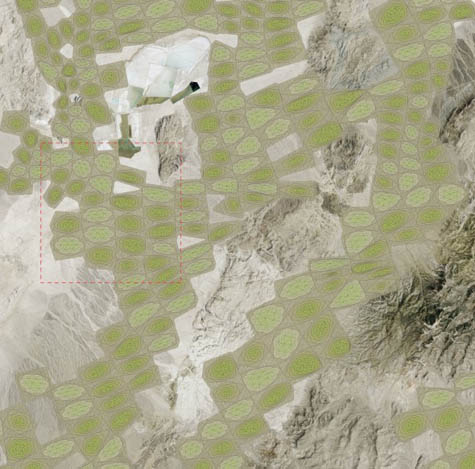Hexagonal Hydropolis
 [Image: From Sietch Nevada by Matsys; renderings by Nenad Katic].
[Image: From Sietch Nevada by Matsys; renderings by Nenad Katic].Andrew Kudless of Matsys recently proposed an extraordinary desert city of semi-subterranean terraces inspired by the novel Dune.
The images are fantastic, and the project description hooked me right away:
- In Frank Herbert’s famous 1965 novel Dune, he describes a planet that has undergone nearly complete desertification. Dune has been called the “first planetary ecology novel” and forecasts a dystopian world without water. The few remaining inhabitants have secluded themselves from their harsh environment in what could be called subterranean oasises. Far from idyllic, these havens, known as sietch, are essentially underground water storage banks. Water is wealth in this alternate reality. It is preciously conserved, rationed with strict authority, and secretly hidden and protected.
 [Image: From Sietch Nevada by Matsys; renderings by Nenad Katic].
[Image: From Sietch Nevada by Matsys; renderings by Nenad Katic].Continuing to quote at length:
- Although this science fiction novel sounded alien in 1965, the concept of a water-poor world is quickly becoming a reality, especially in the American Southwest. Lured by cheap land and the promise of endless water via the powerful Colorado River, millions have made this area their home. However, the Colorado River has been desiccated by both heavy agricultural use and global warming to the point that it now ends in an intermittent trickle in Baja California. Towns that once relied on the river for water have increasingly begun to create underground water banks for use in emergency drought conditions. However, as droughts are becoming more frequent and severe, these water banks will become more than simply emergency precautions.
In this context, I would unhesitatingly recommend Marc Reisner's classic book Cadillac Desert – the first hydrological page-turner I've ever read – as well as James Lawrence Powell's recent Dead Pool: Lake Powell, Global Warming, and the Future of Water in the West (which I reviewed for The Wilson Quarterly earlier this year). Those two books are ideal references for Matsys's project, as they each supply countless examples of hubristic, quasi-imperial waterbanking projects – projects that might still be functioning today but that are doomed, the authors convincingly show, to eventual dehydration.
Powell, in particular, offers genuinely disturbing descriptions of the looming silt-deposits that have accumulated behind the dams of the American west, amongst often extraordinarily poetic overviews of these dams' inevitable failure. “One day every trace of the dams and their reservoirs will be gone," Powell writes, "a few exotic grains of concrete the only evidence of their one-time existence.”
 [Image: Matsys's Sietch Nevada as seen from above; renderings by Nenad Katic].
[Image: Matsys's Sietch Nevada as seen from above; renderings by Nenad Katic].In any case, the proposal seen here is "an urban prototype," we read, "that makes the storage, use, and collection of water essential to the form and performance of urban life."
- A network of storage canals is covered with undulating residential and commercial structures. These canals connect the city with vast aquifers deep underground and provide transportation as well as agricultural irrigation. The caverns brim with dense, urban life: an underground Venice. Cellular in form, these structures constitute a new neighborhood typology that mediates between the subterranean urban network and the surface level activities of water harvesting, energy generation, and urban agriculture and aquaculture. However, the Sietch is also a bunker-like fortress preparing for the inevitable wars over water in the region.
(Spotted on Architecture MNP. And read Dune!)





Comments are moderated.
If it's not spam, it will appear here shortly!
This concept is very creative and perhaps even visionary.
That being said, it has some major issues that would need to be addressed. Here are just a couple off the top of my head:
1) This is strip mining on a nearly unimaginable scale, removing (to where?) what looks like easily tens of square miles of earth to a depth of hundredths of feet without somehow fouling the precious aquifer Mr. Kudless hopes to access . What are the ecological repercussions of doing that?
2) Then, within that massive excavation you then need to construct whole cities along with their infrastructures underground and then seal them up. All of the above at what seems colossal costs.
If the purpose of the domes is to prevent evaporation and create more humid microclimates, then why not just keep a version of the tap wells already being employed and build sealed (mega) structures on the surface? It seems the same results could be achieved at significant less costs and ecological disruption. True the cooling effects of living underground would not be realized, but it seems that could be offset by solar (which that region has in abundance) and wind power.
I'm not attacking the concept, I'm just wondering if the plan as conceived is financially and ecologically the most efficient.
So then, what if instead of mining downward or building on a flat surface, one were to take this design and build across a valley with it, essentially filling in an area? All theory of course. In this hypathetical, reuse the material of one city to build another. If we are to undertake one monumental project, we may as well make it 'greener' by not expanding urbanism and shrinking wilderness, but rather re-constructing what we already have.
Post a Comment